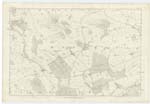OS1/13/54/33
| List of names as written | Various modes of spelling | Authorities for spelling | Situation | Description remarks |
|---|---|---|---|---|
| MAIDEN CASTLE (Site of Supposed Fort) | Maiden's Castle Maiden's Castle Maiden Castle Maiden Castle |
Charles Kinnaird Esqr. Kinloch House James Bogie Esqr. Kinloch Leighton's Hist. [History] of Fife Stat: Acct: [Statistical Account] |
010 | [situation] About 5/8 of a mile N.E. by E. [Northeast by East] of the village of Collessie. The site of this fort or camp is pointed out on a small eminence on the south side of the road leading from Trafalgar to Auchtermuchty, planted with Fir Trees, where it is said a strong fortified camp once stood, It was erected there for the purpose of defending the pass which lead from Newburgh and Perth, inwards thro Fife It is supposed to have been a place of considerable strength surrounded by a deep ditch tho no trace of either camp or ditch remains to be seen at the present time It is said to have derived its name from the valorous conduct of a daughter of one of the governors of the camp which during his illness was besieged by an enemy. but the daughter not wishing the illness of her Father should be known to the soldiers, issued orders to them herself, causing them to sally forth on the besiegers which so harassed the enemy that they were obliged to raise the siege and retire from before the place. |
| Site of Supposed FORT [Maiden Castle] | Maiden's Castle Maiden's Castle Maiden Castle Maiden Castle | Charles Kinnaird Esqr. Kinloch House James Bogie Esqr. Kinloch Leighton's Hist. [History] of Fife Stat: Acct: [Statistical Account] |
010 | [situation] About 5/8 of a mile N.E. by E. [Northeast by East] of the village of Collessie. The site of this fort or camp is pointed out on a small eminence on the south side of the road leading from Trafalgar to Auchtermuchty, planted with Fir Trees, where it is said a strong fortified camp once stood, It was erected there for the purpose of defending the pass which lead from Newburgh and Perth, inwards thro Fife It is supposed to have been a place of considerable strength surrounded by a deep ditch tho no trace of either camp or ditch remains to be seen at the present time It is said to have derived its name from the valorous conduct of a daughter of one of the governors of the camp which during his illness was besieged by an enemy. but the daughter not wishing the illness of her Father should be known to the soldiers, issued orders to them herself, causing them to sally forth on the besiegers which so harassed the enemy that they were obliged to raise the siege and retire from before the place. |
Continued entries/extra info
33 Parish of Collessie Plan 10C Trace 5[Note arrowed to "Site of" and "British Fort"] Stump [Print Style]
[Note arrowed to "Maiden Castle"] Old English [Print style]
[Note] See preceding page.
[Note] See Note page 20
[Note] The eminence is the site of the Fort. The name "Maiden Castle" is the ancient name and descriptive of the object. The designation Maiden as Chalmers remarks is often applied to Forts in Scotland and is the British mai din i.e. the "Great Fort" Therefore the name Maiden Castle is a [pleoname] as it is almost evident Castle in this case is from the Gaelic "Caisteal" a fort etc. From this view it would evidently be erroneous to write the ancient name which is descriptive of the object in stump as if it were equally modern and equally erroneous to write the modern designation as antiquity [initialled] o.m.o. Note the name Gask Hill is not a case in point.
[Note - centre page] Maiden Castle appears to be the popular name of the eminence on which the fort was situated: the Fort was the antiquity, not the eminence on which it stands. See Gask Hill where the popular name is properly in Clump and the name of the antiquity Tumulus in Old English.
Transcriber's notes
There being two pre-populated titles, but only one description, I have copied the information into both. Moderator.Transcribers who have contributed to this page.
MaxInSpain
Location information for this page.
Linked mapsheets.




